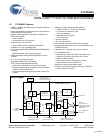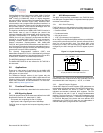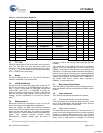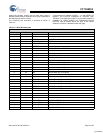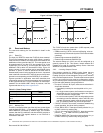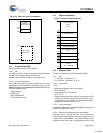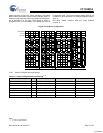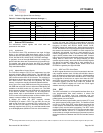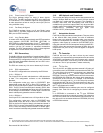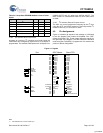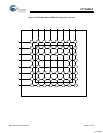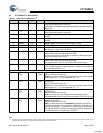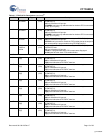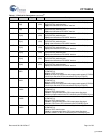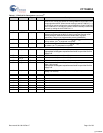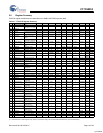
CY7C68053
Document # 001-06120 Rev *F Page 5 of 39
3.9 Reset and Wakeup
The reset and wakeup pins are described in detail in this
section.
3.9.1 Reset Pin
The input pin, RESET#, resets the FX2LP18 when asserted.
This pin has hysteresis and is active LOW. When a crystal is
used with the CY7C68053, the reset period must allow for the
stabilization of the crystal and the PLL. This reset period must
be approximately 5 ms after VCC has reached 3.0V. If the
crystal input pin is driven by a clock signal the internal PLL
stabilizes in 200 µs after VCC has reached 3.0V
[2]
. Figure 3-2
shows a power on reset condition and a reset applied during
operation. A power on reset is defined as the time reset is
asserted while power is being applied to the circuit. A powered
reset is defined to be when the FX2LP18 has previously been
powered on and operating and the RESET# pin is asserted.
Cypress provides an application note which describes and
recommends power on reset implementation and can be found
on the Cypress web site. For more information on reset imple-
mentation for the MoBL-USB™ family of products, visit the
Cypress web site at http://www.cypress.com.
3.9.2 Wakeup Pins
The 8051 puts itself and the rest of the chip into a power-down
mode by setting PCON.0 = 1. This stops the oscillator and PLL.
When WAKEUP is asserted by external logic, the oscillator
restarts, after the PLL stabilizes, and then the 8051 receives a
wakeup interrupt. This applies whether or not FX2LP18 is
connected to the USB.
The FX2LP18 exits the power-down (USB suspend) state
using one of the following methods:
• USB bus activity (if D+/D– lines are left floating, noise on
these lines may indicate activity to the FX2LP18 and initiate
a wakeup)
• External logic asserts the WAKEUP pin
• External logic asserts the PA3/WU2 pin
The second wakeup pin, WU2, can also be configured as a
general purpose IO pin. This allows a simple external R-C
network to be used as a periodic wakeup source. Note that
WAKEUP is by default active LOW.
3.9.3 Lowering Suspend Current
Good design practices for CMOS circuits dictate that any
unused input pins must not be floating between V
IL
and V
IH
.
Floating input pins will not damage the chip, but can substan-
tially increase suspend current. To achieve the lowest suspend
current, any unused port pins must be configured as outputs.
Any unused input pins must be tied to ground. Some examples
of pins that need attention during suspend are:
• Port pins. For Port A, B, D pins, extra care must be taken in
shared bus situations.
— Completely unused pins must be pulled to V
CC_IO
or
GND.
— In a single-master system, the firmware must output en-
able all the port pins and drive them high or low, before
FX2LP18 enters the suspend state.
— In a multi-master system (FX2LP18 and another proces-
sor sharing a common data bus), when FX2LP18 is sus-
pended, the external master must drive the pins high or
low. The external master may not let the pins float.
• CLKOUT. If CLKOUT is not used, it must be tri-stated during
normal operation, but driven during suspend.
• IFCLK, RDY0, RDY1. These pins must be pulled to V
CC_IO
or GND or driven by another chip.
• CTL0-2. If tri-stated via GPIFIDLECTL, these pins must be
pulled to V
CC_IO
or GND or driven by another chip.
• RESET#, WAKEUP#. These pins must be pulled to V
CC_IO
or GND or driven by another chip during suspend.
Figure 3-2. Reset Timing Plots
V
IL
0V
1.8V
1.62V
T
RESET
V
CC
RESET#
Power on Reset
T
RESET
V
CC
RESET#
V
IL
Powered Reset
1.8V
0V
Table 3-3. Reset Timing Values
Condition T
RESET
Power on Reset with crystal 5 ms
Power on Reset with external
clock
200 µs + Clock stability time
Powered Reset 200 µs
Note
2. If the external clock is powered at the same time as the CY7C680xx and has a stabilization wait period, it must be added to the 200 µs.
[+] Feedback



